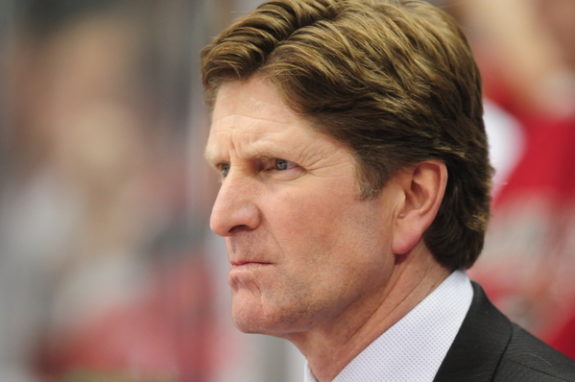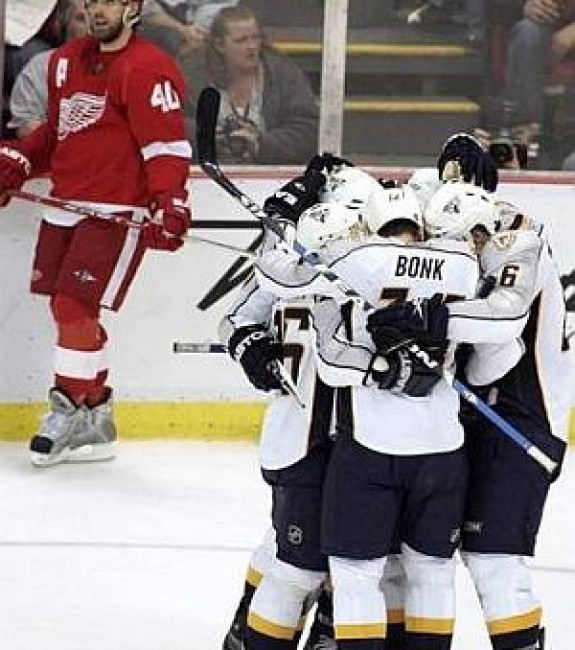Remember the last seconds of the Detroit Red Wings’ Cup-clinching win against the Pittsburgh Penguins in 2008?
The puck waffles near an open goalmouth. Penguins forward Marian Hossa makes a push for the net. Doc Emrick’s “Save, Osgood!” narrates the final gasp of a championship effort as the final horn sounds, a moment of pure chaos crossing over into a moment of pure bliss.
Related: What’s in a Name? The NHL’s Original Six
Within seconds, equipment is scattered all over the ice, the Red Wings players trap their goaltender under a pile of bodies in celebration, and the Pittsburgh crowd is left in stunned silence to wonder, “What happened?”
Well, Chris Osgood happened. The then-35-year-old goaltender pitched a shutout in Games 1 and 2 and posted a .930 save percentage (SV%) against the Pens to earn his third Cup with Detroit, an impressive mark that’s made even more spectacular by coming against a star-studded lineup that included the likes of Hossa, Sidney Crosby, and Evgeni Malkin.

And, of course, throw in the fact that he entered the playoffs as Detroit’s backup.
Let’s Go Back
Following a first-round upset by the Los Angeles Kings in the first round of the 2001 playoffs, Red Wings general manager Ken Holland got ambitious. He signed forwards Luc Robitaille and Brett Hull and traded for goaltender Dominik Hasek, acquiring three Hall-of-Fame talents for a team that already had seven on its roster.
The plan worked. The Wings won their third Cup in six years, Hull and Robitaille were as good as advertised, and Hasek out-dueled Patrick Roy in a memorable, seven-game Western Conference Final before Detroit eventually took down the Carolina Hurricanes for all the marbles.
Related: 5 Forgotten New York Islanders
Osgood, meanwhile, enjoyed the Cup Final from his couch. He was outperformed the previous season by backup Manny Legace, posting a 25-19-4 record with a .904 save percentage (SV%) and 2.69 goals-against average (GAA), while Legace went 24-5-5 with a .920 SV% and 2.05 GAA.

And you can bet — especially in this town — that when the Wings lost to the Kings in six games, goaltending was at the center of Detroit’s failures. With the arrival of Hasek, the logical odd-man-out was Osgood.
He was claimed off waivers by the New York Islanders, seemingly ending a tumultuous career in Detroit that saw him give away a Game 7 in 1994 against the Sharks, get replaced by Mike Vernon in the years leading up to the 1997 Cup win, before ultimately taking the reins for a repeat in 1998.
But his hiatus wouldn’t last long. He was re-signed by the team in 2005, and later split time again with Hasek, who returned again in 2006 to take the No. 1 job.
Hasek Claims Starting Job
Detroit, in the 2007-08 season, finished with the top record in the league for the fourth time in six years. Henrik Zetterberg, Pavel Datsyuk, Johan Franzen and Niklas Kronwall had led a seamless transition into a new era of Red Wings hockey, while guys like Kris Draper, Kirk Maltby, Tomas Holmstrom, Darren McCarty and Nicklas Lidstrom remained from the 1997 to 2002 glory years. But with everybody in that second group on the wrong side of 35 (and in the case of Hasek, on the wrong side of 40), the playoffs represented a different beast.
The Wings were ousted by the No. 8-seeded Edmonton Oilers in the first round in 2006 after finishing with the second-most points in team history. They fell to the Anaheim Ducks in the Western Conference Final a year later.

But the 2008 playoffs got off to a solid start, as the Wings shut Nashville down to open the series and took a 2-0 lead to the Music City after a controversial Game 2, featuring a waved off Predators goal and a goal by Lidstrom that counted, but probably shouldn’t have.
Hasek, who had just turned 43 a few months prior, accompanied Osgood in a goaltending tandem that split games during the regular season. They each started more than 40 games, with head coach Mike Babcock giving Hasek the nod in net come playoff time. And through those first two games, it looked like the right decision.
“Dom is the story,” Babcock said after Game 2. “We turned the puck over in the first period more times than we would give up in five games.”
“Lidstrom, Draper help Wings take advantage of Preds, claim 2-0 series lead,” Associated Press, 04/13/2008
Datsyuk sniped one past Nashville goaltender Dan Ellis to break a 2-2 tie just 40 seconds into the third period of Game 3, as the Red Wings needed a little more than 19 minutes of strong, defensive hockey to more or less end Nashville’s hopes of a comeback.
That’s where things get hairy.
Osgood’s Big Break
By the time of Datsyuk’s third-period tally, things were beginning to turn for the Hasek. The Wings had already seen a 2-0 lead erased to close out the second, thanks to a pair of Nashville goals just 2:08 apart. Hasek maintained the one-goal lead for most of the third period, but when it counted, the Preds were too much.
Related: Top 5 Coaches of the Decade
Ryan Suter scored on a shot from the point that got past an unscreened Hasek with 3:57 to go. Nine seconds later, Jason Arnott entered the zone, ripped another slap shot from the point, scored the game-winner, and gave Nashville new life in an eventual 5-3 win.

Then came Game 4. Hasek was pulled after giving up 3 goals on 14 shots. It would be the final NHL appearance of his 16-year, Hall-of-Fame career.
Osgood took his place, giving up just one goal in the 54 shots he faced from Nashville the rest of the way. He refused to give the net back to Hasek, posting an outstanding 1.55 GAA throughout the playoffs. The Wings would take a tightly contested Game 5 that went to overtime before sealing the first-round series with a 3-0 win in Game 6.
And the rest, as they say, is history.